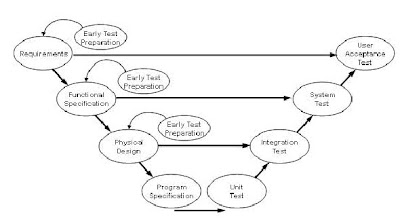v model to w model
V-Model:
The V-model promotes the idea that the dynamic test stages (on the right hand side of the model) use the documentation identified on the left hand side as baselines for testing. The V-Model further promotes the notion of early test preparation.
The V-Model of testing
Early test preparation finds faults in baselines and is an effective way of detecting faults early. This approach is fine in principle and the early test preparation approach is always effective. However, there are two problems with the V-Model as normally presented.
There is rarely a perfect, one-to-one relationship between the documents on the left hand side and the test activities on the right. For example, functional specifications don’t usually provide enough information for a system test. System tests must often take account of some aspects of the business requirements as well as physical design issues for example. System testing usually draws on several sources of requirements information to be thoroughly planned.
V-Model has little to say about static testing at all. The V-Model treats testing as a back-door activity on the right hand side of the model. There is no mention of the potentially greater value and effectiveness of static tests such as reviews, inspections, static code analysis and so on. This is a major omission and the V-Model does not support the broader view of testing as a constantly prominent activity throughout the development lifecycle.
W Model:

The W-Model of testing
Paul Herzlich introduced the W-Model approach in 1993. The W-Model attempts to address shortcomings in the V-Model. Rather than focus on specific dynamic test stages, as the V-Model does, the W-Model focuses on the development products themselves. Essentially, every development activity that produces a work product is shadowed by a test activity. The purpose of the test activity specifically is to determine whether the objectives of a development activity have been met and the deliverable meets its requirements. In its most generic form, the W-Model presents a standard development lifecycle with every development stage mirrored by a test activity. On the left hand side, typically, the deliverables of a development activity (for example, write requirements) is accompanied by a test activity test the requirements and so on. If your organization has a different set of development stages, then the W-Model is easily adjusted to your situation. The important thing is this: the W-Model of testing focuses specifically on the product risks of concern at the point where testing can be most effective.

The W-Model and static test techniques.
If we focus on the static test techniques, you can see that there is a wide range of techniques available for evaluating the products of the left hand side. Inspections, reviews, walkthroughs, static analysis, requirements animation as well as early test case preparation can all be used.

The W-Model and dynamic test techniques.
If we consider the dynamic test techniques you can see that there is also a wide range of techniques available for evaluating executable software and systems. The traditional unit, integration, system and acceptance tests can make use of the functional test design and measurement techniques as well as the non-functional test techniques that are all available for use to address specific test objectives.
The W-Model removes the rather artificial constraint of having the same number of dynamic test stages as development stages. If there are five development stages concerned with the definition, design and construction of code in your project, it might be sensible to have only three stages of dynamic testing only. Component, system and acceptance testing might fit your normal way of working. The test objectives for the whole project would be distributed across three stages, not five. There may be practical reasons for doing this and the decision is based on an evaluation of product risks and how best to address them. The W-Model does not enforce a project symmetry that does not (or cannot) exist in reality. The W-model does not impose any rule that later dynamic tests must be based on documents created in specific stages (although earlier documentation products are nearly always used as baselines for dynamic testing. In projects using these methods, requirements and designs might be documented in multiple models so system testing might be based on several of these models (spread over several documents).
We use the W-Model in test strategy as follows. Having identified the specific risks of concern, we specify the products that need to be tested; we then select test techniques (static reviews or dynamic test stages) to be used on those products to address the risks; we then schedule test activities as close as practicable to the development activity that generated the products to be tested.


.png)
Comments
The full text is also available on the Gerrard Consulting website here: http://gerrardconsulting.com/?q=node/531 This is probably where the 'authors' obtained this content.
The Article on v model to w model is amazing, gives detailed information about it. Thanks for Sharing the information about one of the Software Testing techniques know the waterfall model For More information check the detail on the Waterfall testing here Software Testing Company
Mens Sexual Power Pills
Buy Viagra Tablet
Order Now : https://bit.ly/3fJMSQ9